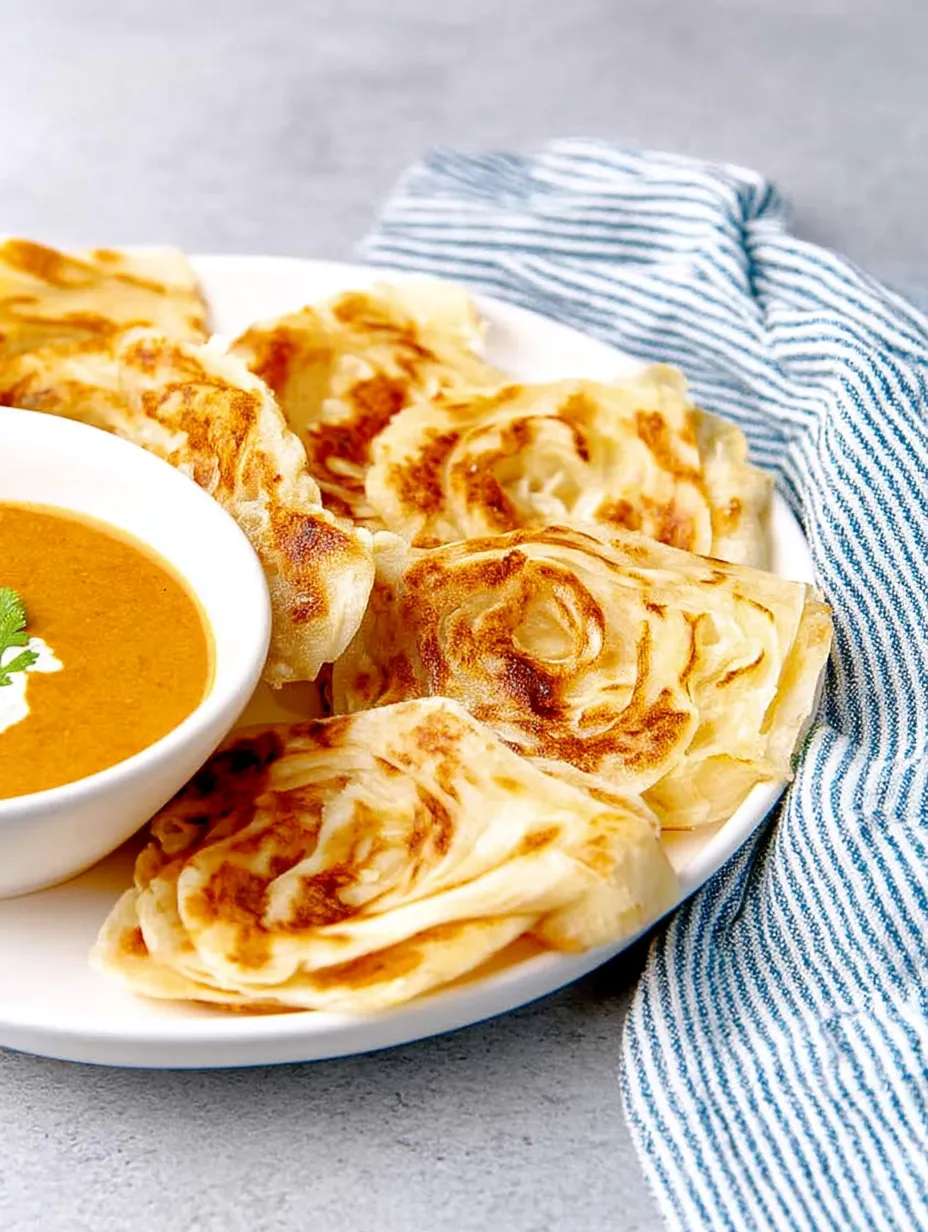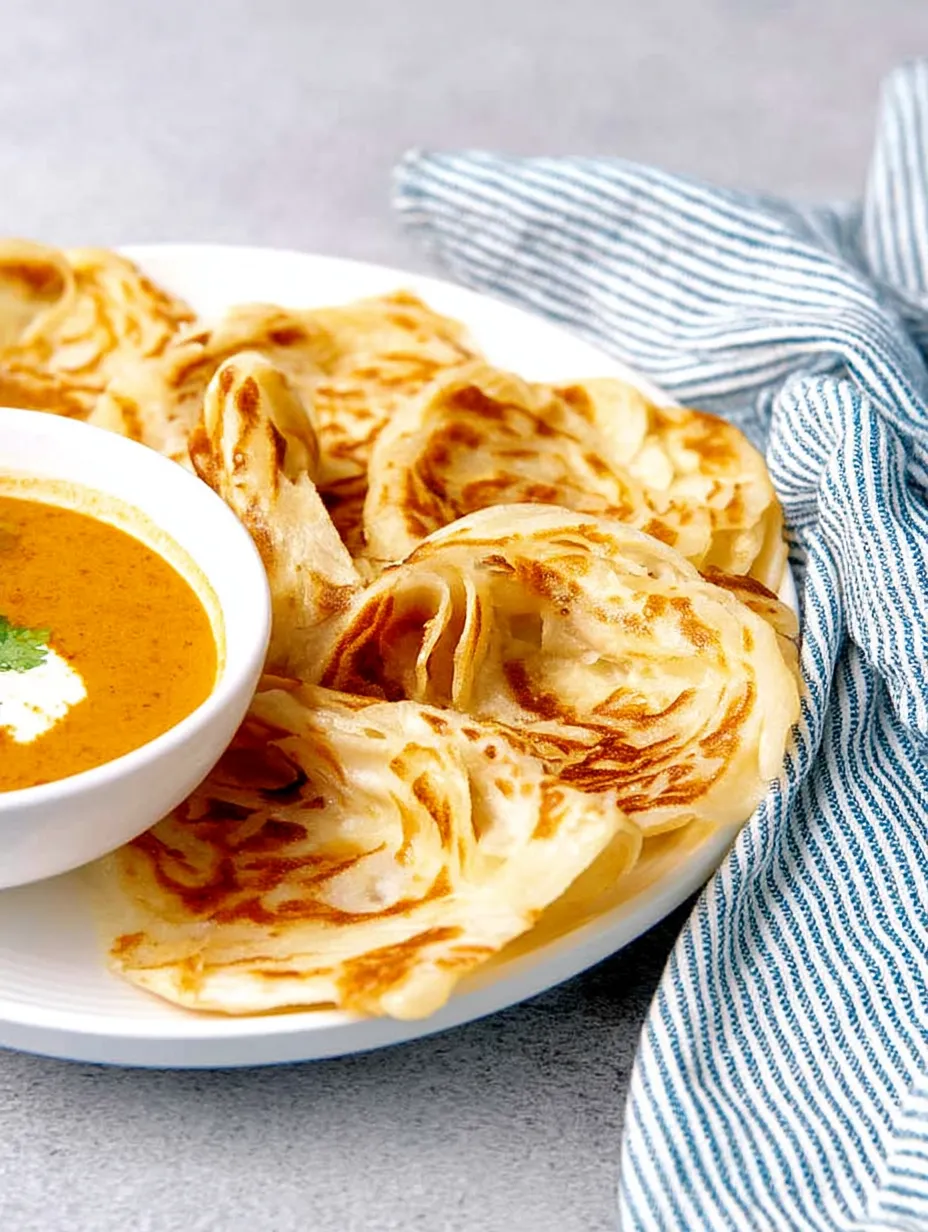 Pin it
Pin it
Discover the art of making perfectly flaky, multi-layered Roti Canai at home with this foolproof recipe. This beloved flatbread features delicate, buttery layers that pull apart effortlessly and are perfect for scooping up savory curries.
The first time I made this roti for friends, they couldn't believe it wasn't from a restaurant. My neighbor, who lived in Malaysia, said it took her back to morning markets watching vendors expertly flip the dough.
Roti Canai Ingredients
- 2 cups all-purpose flour - Bread flour can substitute
- 1/2 teaspoon salt
- 3/4 cup hot water
- 1/4 cup room temperature water
- 1/4 cup vegetable oil (plus extra)
 Pin it
Pin it
Step-by-Step Instructions
- Make the dough
- Combine flour, salt and hot water to form clumps
- Add remaining water
- Gradually add room temp water until soft dough forms
- Initial rest
- Cover and rest 20-30 minutes
- Knead to smoothness
- Knead 1-2 minutes until elastic
- Divide and coat
- Form 8 balls, coat with oil
- Extended rest
- Rest 1 hour to overnight
- Stretch the dough
- Stretch each ball paper-thin
- Create layers
- Brush with oil, coil or fold
- Second rest
- Rest coiled dough 15-30 minutes
- Final shaping
- Flatten into 6-7 inch circles
- Cook the roti
- Cook 2-3 minutes per side
- Activate layers
- Clap hot roti between hands
The Art of Perfect Layers
- Double resting periods are essential
- Oil coating prevents layers from fusing
- Clapping separates layers after cooking
- Stretching creates thin, even sheets
 Pin it
Pin it
Regional Variations
- Roti Canai (Malaysian) - Coiled circle
- Roti Paratha (Indian) - Square layers
- Godhambara Roti (Sri Lankan) - Thinner, less folded
- Scallion Pancake - With chopped scallions
Serving Suggestions
- Breakfast: Egg Roti or Kottu Roti
- Main Meals: With curry or dhal
- Dessert: Cinnamon sugar or Nutella banana
I learned from my grandmother, watching her coax dough into thin sheets. The smell cooking transports me back to her kitchen where we'd tear into fresh bread with fragrant curry.
Roti Canai represents the fusion of Southeast Asian cultures. This humble bread connects us to cherished culinary traditions across generations.
Frequently Asked Questions
- → Why does the dough need so much resting time?
- The multiple resting periods are crucial for developing the gluten structure and allowing the dough to relax. The first rest after forming the dough helps with gluten development. The second longer rest (2-12 hours) allows the gluten to relax, making the dough more elastic and easier to stretch paper-thin without tearing. The final rest after shaping helps the layered structure set, resulting in the characteristic flaky texture when cooked.
- → Can I make roti canai without stretching the dough so thin?
- Stretching the dough until it's paper-thin is essential for creating the signature flaky layers of authentic roti canai. While it takes practice to stretch without tearing, even imperfect attempts will yield delicious results. If you can't stretch it completely translucent, just do your best - each time you make it, you'll improve your technique.
- → What's the difference between roti canai, roti paratha, and murtabak?
- Roti canai and roti paratha are essentially the same flatbread, with slight regional naming differences (canai in Malaysia, paratha in India and Pakistan). Both feature a flaky, layered texture created through a stretching and folding technique. Murtabak is a stuffed version of roti, typically filled with minced meat, eggs, and onions before being folded and cooked.
- → Can I freeze roti canai dough?
- Yes, you can freeze roti canai at two stages: either after portioning the dough (before the long rest) or after it has been coiled (before the final rest). Wrap each portion well in plastic wrap and place in a freezer bag. Thaw completely at room temperature before proceeding with the next step. You can also freeze fully cooked roti - reheat from frozen in a dry pan over medium-low heat.
- → What's the best way to serve roti canai?
- Traditionally, roti canai is served with dal (lentil curry) or other curry dishes for dipping. In Malaysia, it's commonly eaten for breakfast with a side of curry sauce or dhal. For a sweeter version, try serving it with condensed milk, sugar, or banana for dessert. It's also delicious simply torn into pieces and used to scoop up curry instead of using utensils.
